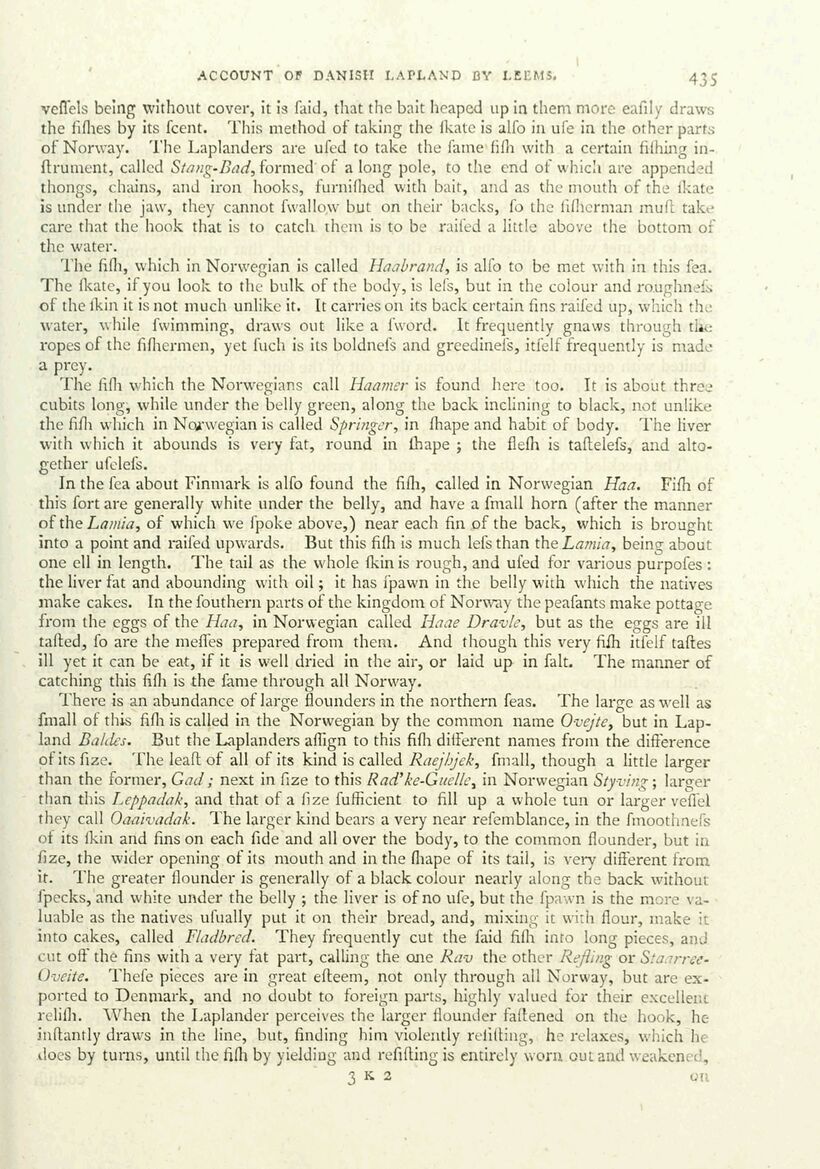
Full resolution (JPEG) - On this page / på denna sida - Pages ...

<< prev. page << föreg. sida << >> nästa sida >> next page >>
Below is the raw OCR text
from the above scanned image.
Do you see an error? Proofread the page now!
Här nedan syns maskintolkade texten från faksimilbilden ovan.
Ser du något fel? Korrekturläs sidan nu!
This page has never been proofread. / Denna sida har aldrig korrekturlästs.
ACCOUNT OF DANISH LAPLAND BY LEUMS, 435
veflels being without cover, it is faid, that the bait heaped up in them more eafily draws
the fifhes by its fcent. This method of taking the {kate is alfo in ufe in the other parts
of Norway. ‘The Laplanders are ufed to take the fame’ fifh with a certain fifhing in-
{trument, called Stang-Bad, formed of along pole, to the end of which are appended
thongs, chains, and iron hooks, furnifhed with bait, and as the mouth of the ikate
is under the jaw, they cannot {wallow but on their backs, fo the fifherman muft take
care that the hook that is to catch them is to be raifed a little above the bottom of
the water.
The fifh, which in Norwegian is called Haabrand, is alfo to be met with in this fea.
The fkate, if you look to the bulk of the body, is lefs, but in the colour and roughnefs
of the ikin it isnot much unlike it. It carries on its back certain fins raifed up, which the
water, while fwimming, draws out like a {word. It frequently gnaws through tle
ropes of the fifhermen, yet fuch is its boldnefs and greedinels, itfelf frequently is made
a prey.
The fifh which the Norwegians call Haamer is found here too. It is about three
cubits long, while under the belly green, along the back inclining to black, not unlike
the fifh which in Nogwegian is called Springer, in fhape and habit of body. ‘The liver
with which it abounds is very fat, round in fhape ; the flefh is taftelefs, and alto-
gether ufelefs.
In the fea about Finmark is alfo found the fifh, called in Norwegian Haa. Fith of
this fort are generally white under the belly, and have a fmall horn (after the manner
of the Lamia, of which we {poke above,) near each fin of the back, which is brought
into a point and raifed upwards. But this fifh is much lefs than the Lamia, being about
one ell in length. The tail as the whole fkinis rough, and ufed for various purpofes :
the liver fat and abounding with oil; it has fpawn in the belly with which the natives
make cakes. In the fouthern parts of the kingdom of Norway the peafants make pottage
from the eggs of the Haa, in Norwegian called Haae Dravie, but as the eggs are ill
tafted, fo are the mefles prepared from them. And though this very fith itfelf taftes
ill yet it can be eat, if it is well dried in the air, or laid up in falt. The manner of
catching this fifh is the fame through all Norway.
There is an abundance of large flounders in the northern feas. The large as well as
{mall of this fifh is called in the Norwegian by the common name Ovejte, but in Lap-
land Ba/des. But the Laplanders aflign to this fith different names from the difference
ofits fize. ‘The leaft of all of its kind is called Raejlyek, fmall, though a little larger
than the former, Gad ; next in fize to this Rad’ ke-Guelle, in Norwegian Styving ; larger
than this Leppadak, and that of a fize fufficient to fill up a whole tun or larger vefiel
they call Oaaivadak. The larger kind bears a very near refemblance, in the fmoothnefs
of its {kin and fins on each fide and all over the body, to the common flounder, but in
fize, the wider opening of its mouth and in the fhape of its tail, is very different from
it. The greater flounder is generally of a black colour nearly along the back without
{fpecks, and white under the belly ; the liver is of no ufe, but the {pawn is the more va-
luable as the natives ufually put it on their bread, and, mixing it with flour, make it
into cakes, called Fladbred. ‘hey frequently cut the faid fifth into long pieces, and
cut off the fins with a very fat part, calling the one Rav the other Refling or Stacrree-
Oveite. ‘Thefe pieces are in great efteem, not only through all Norway, but are ex-
ported to Denmark, and no doubt to foreign parts, highly valued for their excellence
relifh. When the Laplander perceives the larger flounder faftened on the hook, he
inftantly draws in the line, but, finding him violently refitting, he relaxes, which he
does by turns, until the fifh by yielding and refifting is entirely worn out and weakened,
3K 2 on
<< prev. page << föreg. sida << >> nästa sida >> next page >>